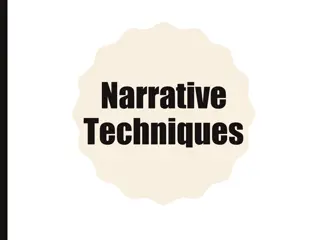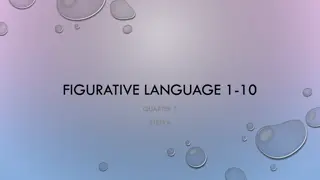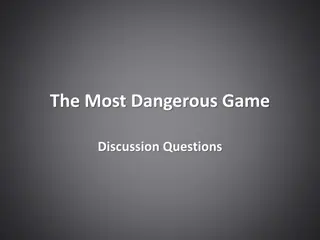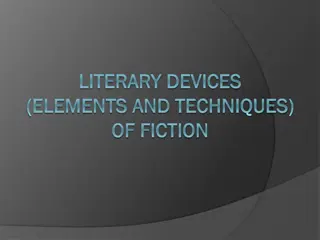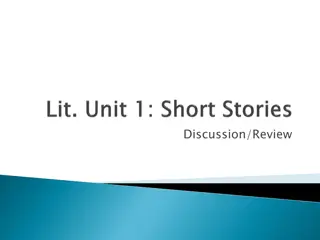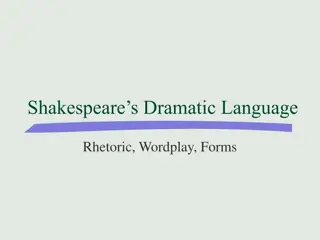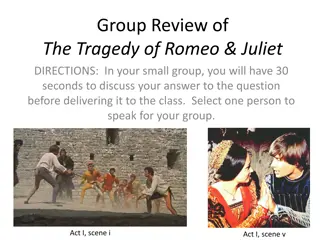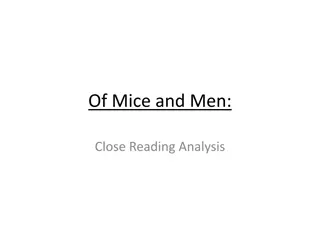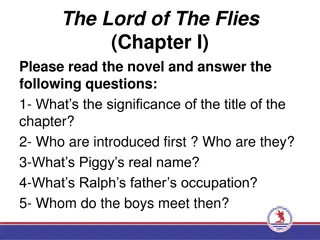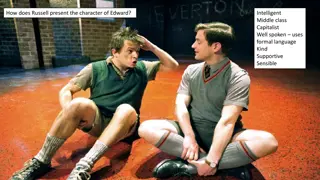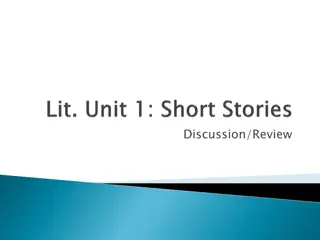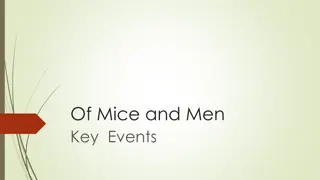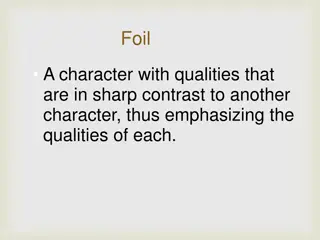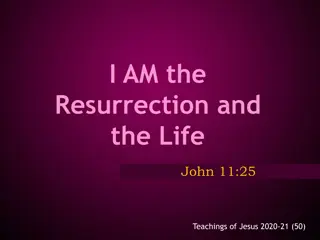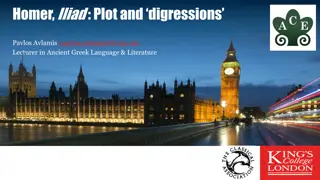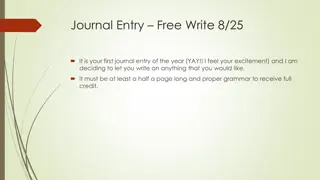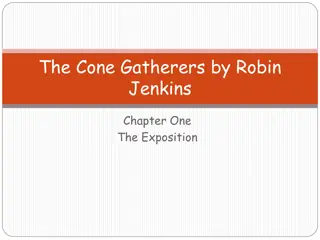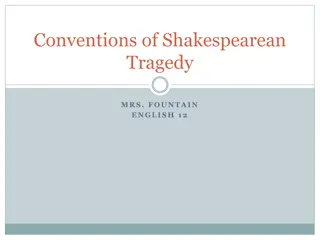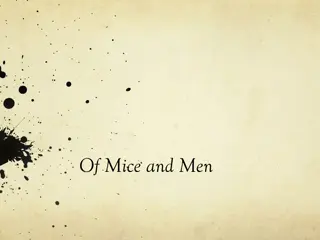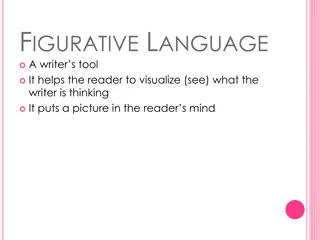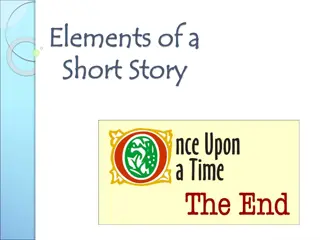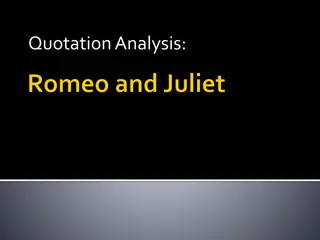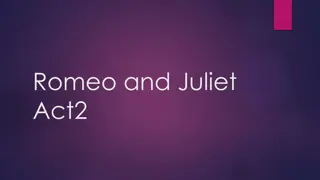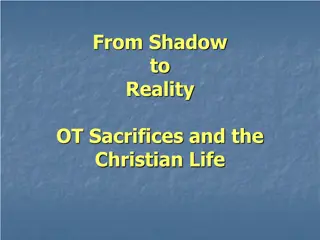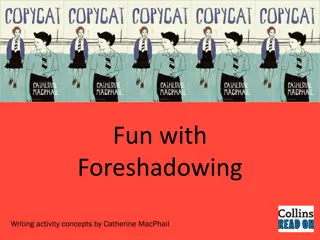Foreshadowing
Foreshadowing is a literary technique where authors use hints or clues to suggest future events in a story. It builds suspense, engages readers, and makes the narrative more believable. Analyzing foreshadowing involves looking for clues in dialogue and descriptions to predict what might happen next.
0 views • 8 slides
Exploring Narrative Techniques in Storytelling
Delve into the world of narrative techniques used in storytelling, including first person narration, flashbacks, framed narratives, and foreshadowing. Understand how these techniques shape the way stories are told and immerse readers in captivating storytelling experiences.
0 views • 19 slides
Understanding Narrative Techniques for Effective Storytelling
Explore different narrative techniques like first-person perspective, flashback, framed narrative, foreshadowing, and in medias res to enhance your storytelling skills. Learn how these techniques can bring depth and complexity to your narratives, captivating your audience with engaging storytelling
3 views • 13 slides
Understanding Literary Devices: A Comprehensive Guide
Explore the world of literature with this detailed guide on figurative language, characterization, conflict, connotation, denotation, epiphany, foreshadowing, and imagery. Discover how authors skillfully use these literary devices to enhance storytelling and engage readers in meaningful ways. Each c
2 views • 11 slides
Analyzing "The Most Dangerous Game" Characters, Plot, and Themes
Explore the characters Rainsford, General Zaroff, Whitney, and Ivan, as well as the intense conflict between Rainsford and Zaroff in the story "The Most Dangerous Game." Delve into themes of foreshadowing, hunting, and ethical dilemmas set on Ship Trap Island.
0 views • 11 slides
Explore Literary Devices and Elements of Fiction
Dive into the world of literary devices and elements of fiction, including setting, mood, plot, flashback, and foreshadowing. Understand how sensory details enhance writing and learn about techniques such as allusion, figurative language, and more. Discover the significance of these elements in shap
1 views • 28 slides
Exploring the Thrilling Plot and Themes of 'The Most Dangerous Game'
Delve into the riveting plot of "The Most Dangerous Game" as Rainsford faces off against General Zaroff in a deadly duel on Ship-Trap Island. Explore the conflicts, characters, setting, suspenseful elements, themes of strength versus weakness, and literary techniques like irony and foreshadowing wov
0 views • 40 slides
Divine Typology and Foreshadowing in Biblical Narratives
Typology in Christianity involves interpreting Old Testament figures, events, and symbols as foreshadowing future events related to Jesus Christ. By recognizing these divine hints in stories like Joseph and Moses, believers can find reassurance and a deeper understanding of God's plan throughout Scr
0 views • 18 slides
Exploring Shakespeare's Dramatic Language and Themes
Shakespeare's dramatic language entails rhetoric, wordplay, and rich forms that offer both pleasure and challenges to readers. His verse showcases density and richness, with characters expressing thoughts through powerful metaphors and figurative language. Examples from "Macbeth" illustrate how imag
0 views • 40 slides
Exploring Key Themes and Characters in 'Romeo & Juliet' Act I
Dive into the first act of "Romeo & Juliet" with discussions on conflict, characterization, motivation, foreshadowing, puns, asides, and family relationships. Explore the sources of tension, the Nurse's role, Romeo's friends and their plans, foreshadowing of events, witty puns, strategic asides, and
0 views • 9 slides
Exploring Key Literary Devices in Writing
Literary devices such as foreshadowing, suspense, irony, symbolism, and tone are essential tools that authors use to enhance their writing. Foreshadowing hints at future events, suspense keeps readers engaged, irony adds depth, symbolism conveys deeper meanings, and tone sets the author's attitude.
1 views • 16 slides
Exploring Foreshadowing and Tension in "The Red Room
Dive into the world of foreshadowing and tension in the classic tale "The Red Room" by H.G. Wells. Uncover how the author sets the stage for suspense and anticipates significant events, examining the characters, setting, and storytelling techniques employed. Explore the questions of belief in ghosts
0 views • 18 slides
Foreshadowing in "Of Mice and Men": Analysis of Curley's Wife's Introduction
In this close reading analysis of a passage from "Of Mice and Men," the significance of Curley's wife's introduction is explored. The use of symbolism and foreshadowing through descriptions of her appearance hint at the dark role she will play in the novel, linking the color red to danger and death.
0 views • 4 slides
Analysis of "The Lord of the Flies" Chapters I-IV
A detailed examination of key elements and events in chapters I to IV of "The Lord of the Flies", including character introductions, symbolism, foreshadowing, conflicts, and interactions between Jack, Ralph, Piggy, and others stranded on the deserted island.
0 views • 9 slides
Analysis of Themes in Hitchcock's Psycho: A Psychological Thriller
Hitchcock's "Psycho" delves into themes of past influencing the present, abnormal parent-child dynamics, and the unraveling of protagonist Marion Crane's impulsive journey leading to her encounter with Norman Bates. The narrative intricately weaves psychological tension, suspense, and ominous foresh
0 views • 15 slides
Analysis of Characters and Themes in Blood Brothers
Russell presents diverse characters like Edward, Mickey, Mrs. Johnstone, Mrs. Lyons, Sammy, and Linda in a play filled with class divide, manipulation, superstition, and tragic relationships. The structure, narrative style, and themes like fate, foreshadowing, and childhood influences contribute to
0 views • 11 slides
Dream Analysis in "Wide Sargasso Sea" by Savannah Mercure
Explore the subconscious fears and foreshadowing of Antoinette's marriage through vivid dream sequences in the novel "Wide Sargasso Sea" by Savannah Mercure. Antoinette's dreams reveal her deep-seated anxieties and premonitions, offering insights into her character and the challenges she may face ah
0 views • 6 slides
The Most Dangerous Game - Analysis and Themes
A detailed exploration of Richard Connell's classic short story, "The Most Dangerous Game." The plot follows Rainsford's harrowing journey as he is hunted by the menacing General Zaroff on Ship-Trap Island. The conflicts, characters, setting, suspense, themes, point of view, and literary techniques
0 views • 40 slides
Analyzing Themes and Relationships in "The Monkey's Paw
Analyze the hints about future events, the building of suspense, foreshadowing techniques, and the impact on relationships in "The Monkey's Paw." Explore themes of fate, risk-taking, and interference with destiny as the Whites grapple with the consequences of using the cursed monkey's paw.
0 views • 15 slides
Understanding Key Events in "Of Mice and Men": Curley's Attack on Lennie
In Chapter Three of "Of Mice and Men," Curley's attack on Lennie is a key incident that reveals the brutal nature of Curley and the immense strength and vulnerability of Lennie. The event not only showcases effective characterisation but also evokes sympathy for Lennie while foreshadowing the conseq
0 views • 24 slides
Explore Literary Devices in Drama
Delve into the world of drama with an examination of various literary devices such as foils, foreshadowing, similes, metaphors, conflicts, protagonists, antagonists, soliloquies, monologues, asides, irony, dramatic irony, blank verse, iambic pentameter, alliteration, and puns.
0 views • 13 slides
Jesus: The Resurrection and The Life in John 11:25
Jesus declares Himself as the Resurrection and the Life in John 11:25, foreshadowing His own resurrection and emphasizing His divinity. The context of Lazarus' resurrection reveals Jesus' power over death and His mission leading up to His crucifixion and resurrection.
0 views • 20 slides
Homer's Iliad: Plot, Digressions, and Literary Techniques
The focus of Homer's Iliad is on the dramatic action surrounding Achilles and Agamemnon during the Trojan War, highlighting themes of honor and wrath. The poem's narrow focus on specific events is enriched by digressions that expand the plot, providing detailed descriptions, flashbacks, foreshadowin
0 views • 21 slides
Exploring Elements of Storytelling: Plot, Conflict, Setting, and More
Dive into the foundational elements of storytelling including plot development, types of conflict, flashback techniques, foreshadowing, and creating mood through setting. Understand how these components work together to craft engaging narratives across various genres.
0 views • 14 slides
Character Analysis and Exposition in "The Cone Gatherers" by Robin Jenkins
The exposition of "The Cone Gatherers" introduces the characters, their relationships, sources of conflict, setting, narrative voice, motifs, symbols, and foreshadowing. Calum is depicted as having a deep affinity with nature while exhibiting childlike innocence and sensitivity. Neil struggles with
0 views • 11 slides
Exploring Shakespearean Tragedy: Conventions and Characteristics
Delve into the world of Shakespearean tragedy through the examination of key conventions such as the tragic hero, plot development, and themes. Understand the aspects of tragedy and drama, including blank verse, soliloquy, aside, dramatic irony, and foreshadowing. Discover how these elements come to
0 views • 10 slides
Exploring Themes and Techniques in Of Mice and Men
Delve into the world of Steinbeck's classic novella "Of Mice and Men." Analyze characters, themes, and literary devices such as foreshadowing, allegory, and symbolism. Uncover the emotional depth of the story through discussions on imagery, plot symmetry, and poignant scenes. Discover the power of l
0 views • 13 slides
Understanding Figurative Language in Writing
Figurative language is a powerful tool that writers use to enhance their work by creating vivid images in the reader's mind. This includes techniques such as similes, puns, oxymorons, allusions, foreshadowing, and paradoxes, each serving a unique purpose in conveying deeper meanings and engaging the
0 views • 27 slides
Understanding Elements of a Short Story and Their Significance
Short stories consist of key elements such as theme, characterization, dialogue, foreshadowing, and more that contribute to the overall structure and impact of the narrative. Familiarity with these elements helps readers analyze and appreciate the story's nuances effectively.
0 views • 28 slides
Understanding Quotation Analysis and Literary Terms in Literature
Exploring quotation analysis and literary terms in literature is essential for understanding the deeper meaning and context of literary works. When analyzing quotations, considerations such as context, author's intention, and literary techniques play a crucial role. Additionally, familiarizing onese
0 views • 53 slides
Analysis of Literary Devices in Romeo and Juliet Act 2
In Act 2 of Romeo and Juliet, the characters use various literary devices such as allusion, dramatic irony, hyperbole, and foreshadowing. Mercutio mistakenly believes Romeo is still in love with Rosaline, showcasing dramatic irony. Additionally, Friar Lawrence's words foreshadow the danger in Romeo
0 views • 10 slides
Foreshadowing and Sacrifice in the Christian Life
Delve into the concept of foreshadowing in the Old Testament scriptures, uncovering how they point towards the fulfillment found in the life of Christ. Explore the sacrificial symbolism from ancient rituals to their fulfillment in the life and sacrifice of Jesus, reflecting on the deeper meanings be
0 views • 27 slides
Unraveling the Final Chapter of The Odyssey: A Tale of Reveal and Retribution
As we approach the climax of The Odyssey, the anticipation mounts as Odysseus' true identity nears revelation. Predictions swirl around the reactions of characters like Eurycleia and the adherence to the ancient Greek tradition of guest-friendship. Episode 12's title, "A Grim Harvest," sets a forebo
0 views • 11 slides
Foreshadowing Writing Activities by Catherine MacPhail
Engage in creative writing exercises focused on foreshadowing with concepts and examples provided by Catherine MacPhail. Explore how to hint at future events to build suspense and keep readers hooked through intriguing storytelling techniques.
0 views • 4 slides

